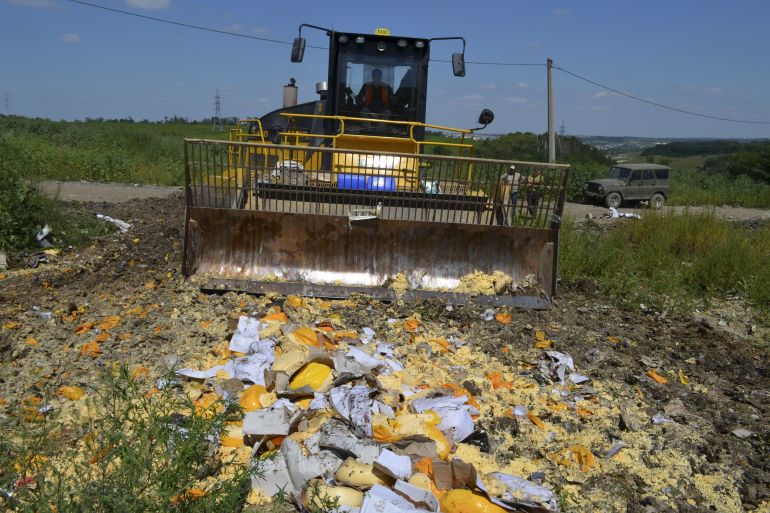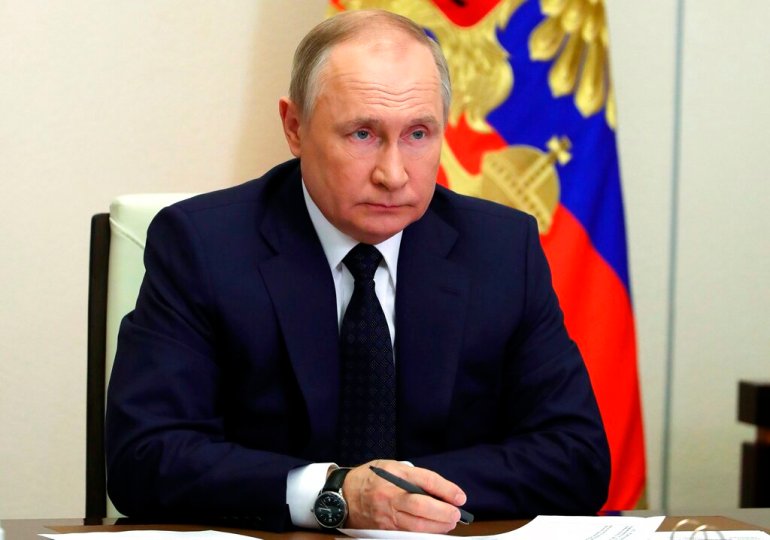For isolated Russia, replacing key imports an uphill battle
Moscow’s aggressive campaign of import substitution since 2014 has had mixed results at best, analysts say.

Russia was cheesed off, so it unleashed bulldozers to flatten plump packets of camembert and peaches imported from countries that had imposed economic penalties on Moscow.
That was August 2015, a year after Russia’s annexation of Crimea led to targeted Western sanctions against select companies and members of Moscow’s political and military elite. In response, President Vladimir Putin had banned the mass purchase of food from nations that had punished Moscow.
Keep reading
list of 4 itemsBrazilian officials resign en masse to boost President Bolsonaro
El Salvador’s Bukele warns gangs lead to ‘prison or death’
Ukraine latest updates: ICRC says Mariupol evacuation on hold
The over-the-top use of bulldozers was aimed at emphasising that Russia did not need foreign cheese and fruit as it developed its domestic industry to reduce its dependence on Western food, tech and other goods.
But eight years after Moscow launched an aggressive campaign of import substitution to insulate its economy from future sanctions, the result has been mixed at best, if not a complete failure, according to experts. At a time when Moscow is battling potentially crippling penalties from the United States, Europe and their allies over the invasion of Ukraine, Russia’s poor preparation could expose the country’s economy in precisely the ways it had hoped to avoid.
AvtoVAZ, Russia’s largest carmaker, which is owned by Renault, has had to suspend operations because it cannot source parts: cars and vehicle components are the country’s biggest imports. SvetoCopy, one of Russia’s most popular office paper brands, has halted work at its mills with Sylvamo, its Memphis-based owner, citing supply shortages and then — five days later — company values.
They are not alone in their struggles. A 2021 note from the central bank of Russia reported that 65 percent of enterprises in the country were dependent on imports for their manufacturing, underscoring the country’s reliance on global supply chains. Surveys of Russian manufacturers by the Moscow-based Gaidar Institute for Economic Policy have repeatedly shown that more than 60 percent of firms say they are unable to find domestic equivalents for goods that they import.
Contrary to the Kremlin’s hopes, Russia’s monthly imports increased by more than 40 percent between February and December 2021, reaching a figure of $30.7bn — the highest for any month since 2014 — before the current wave of US sanctions dampened trade. Russia might also come to rue its destruction of cheese. Between 2013 and 2019, it only managed to cut the value of its dairy imports by 35 percent, with foreign products dominant on its supermarket shelves.
“Generally speaking, the import substitution in Russia is a phantom,” Andrei Kolesnikov, a senior fellow at the Carnegie Moscow Center, told Al Jazeera.

To be sure, Russia has made gains in developing some of its domestic industries over the past eight years, analysts say. The food and agriculture sectors, in particular, have been major beneficiaries, receiving state subsidies to produce alternatives to imports of everything from pork to parmesan. By 2019, Russia’s import bill for meat was down by 70 percent compared with 2013, according to UN Comtrade data — though the dip for fruits was much more modest, at only 20 percent.
But the bans on Western imports have also reduced competition, driving up prices. Beef is now three times as expensive as it was in May 2014, according to data portal IndexMundi.
“The increased domestic production of some agricultural products in Russia cannot be really considered as successful import substitution as Russian consumers have already paid and continue to pay a significant price for such policy,” Denis Davydov, a senior lecturer in accounting and finance at the University of Vaasa, Finland, told Al Jazeera.
It is a similar story in aerospace, another sector where Russia has managed to develop some domestic alternatives. Since 2014, Moscow has been desperate to fix a major military vulnerability: the engines of its helicopters were imported from Ukraine. JSC Klimov, a Russian company, now manufactures similar engines.
But in the civil aviation space — as with meat — the costs to consumers depends on competition, which a closed market does not allow. The result: Russian-made headlights for planes are three times as expensive as ones made outside the country, according to an analysis by the Moscow Aviation Institute.
“Production in isolation is doomed to be of lower quality and less competitive,” said Davydov, who has closely followed the Russian economy for the past decade.
In other sectors, especially those involving hi-tech equipment or know-how, Russia has struggled even more to build domestic industries that can meaningfully replace imports, analysts say.
“Take the semiconductor industry: it’s impossible to reproduce the whole supply value chain in Russia due to technical issues and the complexity of the process,” Maria Shagina, a visiting senior fellow at the Finnish Institute of International Affairs, told Al Jazeera.
In 2020, Russia imported diodes, transistors and semiconductor-based devices worth $440m, United Nations data shows.
Homegrown tech
Meanwhile, efforts to force even Russian-state-owned organisations to use homegrown tech have failed. In 2015, the Kremlin ordered all government bodies to stop using foreign software. But by late 2019, only 10 percent of software used by state agencies was made in the country, according to Russia’s ICT Import Substitution Competence Center.
Across sectors, things will get worse as more and more foreign companies flee Russia, said David Cortright, director of the Global Policy Initiative at the University of Notre Dame’s Kroc Institute for International Peace Studies.
“There is very little they (Russians) can do to boost domestic production in the industrial and high-tech sectors that matter most,” Cortright told Al Jazeera.
So why has Moscow failed to do better at building domestic industries since 2014?
“Russia’s approach to the policy of import substitution is akin to the Soviet approach — a centralised and top-down policy which doesn’t take into account the complexity of the problem,” Shagina said.
Such a strategy, which puts bureaucrats and politicians in charge of tasks that need subject experts, has led to officials employing dubious methods to bump up imports on paper. Kamil Galeev, a fellow at the Wilson Center, has pointed to one glaring instance where tractor kits were purchased from the Czech Republic, assembled in Russia, and passed off as examples of import substitution.
“With the high level of corruption, current Russian institutional settings make it highly unlikely to achieve any meaningful breakthroughs,” Davydov said.
Russia may be able to use workarounds to overcome some of the shortcomings of its domestic industry. In 2020, 57 percent of its semiconductor imports — worth $249m — came from China, which might not follow US measures against Moscow unless it fears secondary sanctions.
Moscow could also try to reroute the import of Western goods through countries that have not sanctioned Russia — as has already been happening in some sectors.
A study by the Moscow-based National Rating Agency found that Russia pivoted to Chile for fish supplies in 2020, at the same time that the South American country tripled its imports of Norwegian seafood. That year, China sharply increased its exports of vegetables to Russia while itself upping imports of vegetables three-fold from the European Union. And Ecuador became a prime source of fruits for Russia, while increasing its own import of fruits from the European Union seven-fold.
But replicating this approach across the economy without drawing the attention of Western sanctions inspectors will not be easy, analysts say. Crucially, it would also represent an admission of failure — a meek reversal of the bulldozer bravado of past years.
Instead, the legacy of Russia’s import substitution programme will be “higher prices, lower product quality, and heavier state dependency in many sectors of the economy,” Davydov said.